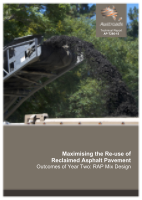Pavement

- Publication no: AP-T286-15
- ISBN: 978-1-925294-04-0
- Published: 30 January 2015
- PDF (free) Download
This report presents the findings from the second year of a three-year Austroads study which aims to maximise the re-use of reclaimed asphalt pavement (RAP) in new asphalt mixes.
A survey was conducted in Australia to identify the important issues that limit the use of RAP in asphalt. A literature review has been conducted to address the issues identified in the survey. Asphalt mixes containing different percentages of RAP were tested in the laboratory to evaluate the impact of RAP on the volumetrics, flexural stiffness, fatigue, permanent deformation and moisture susceptibility of the asphalt mixes.
Viscosity was identified as an important indicator to rank the performance of dense graded asphalt mixes containing different percentages of RAP. For the asphalt mixes tested in this study, increasing viscosity of the binder (after the addition of RAP) will generally increase the stiffness, reduce the rut depth and wheel tracking rate, as well as result in a general reduction of fatigue life.
A guideline for design of RAP mixes is also presented in this report.
- Summary
- Contents
- 1. Introduction
- 1.1. Problem Statement
- 1.2. Objectives and Scope
- 1.3. Structure of the Report
- 2. Literature Review
- 2.1. Issues Regarding Re-use of RAP in Asphalt Mixes
- 2.2. RAP and Stockpile Management
- 2.2.1. General Comments
- 2.2.2. RAP Stockpile Management: Australasian Practices
- 2.2.3. United States of America
- 2.2.4. Europe
- 2.3. Binders in RAP Source Materials
- 2.3.1. Issue of Binder Blending
- 2.3.2. Properties of RAP Binders
- 2.3.3. Discussion on the Use of Very Aged RAP Materials
- 2.4. Manufacturing Practice: RAP Content and Mix Design
- 2.4.1. General Comments
- 2.4.2. Australia and New Zealand
- 2.4.3. USA and Canada
- 2.4.4. European Union
- 2.4.5. Mix Design for Mixes Containing RAP
- 2.5. Performance of Mixes Containing RAP
- 2.5.1. General Comments
- 2.5.2. Structural Performance of Mixes Containing RAP
- 2.5.3. Durability of Asphalt Mixes Containing RAP
- 2.5.4. Functional Performance of Asphalt Mixes Containing RAP
- 2.6. RAP Mix: Other Issues
- 2.6.1. Issues of Using RAP in Warm Mix Asphalt (WMA) Mixes
- 2.6.2. RAP Content Limits in WMA Mixes
- 2.6.3. Observation with Regards to the Benefits of Combining RAP and WMA
- 3. Experimental Methodology
- 3.1. Test Plan
- 3.2. Mix Designs
- 3.2.1. VicRoads AC10(H) Mix – C320 Binder
- 3.2.2. Asphalt Mixes Incorporating RAP
- 3.3. Sample Conditioning
- 3.4. Asphalt Volumetrics
- 3.5. Designed Binder Blend
- 3.6. Performance-related Testing of RAP Mixes
- 3.6.1. Frequency Temperature Sweeps – Flexural Stiffness
- 3.6.2. Fatigue Test – Four-Point Bending Beam
- 3.6.3. Wheel Tracking Test
- 3.6.4. Moisture Sensitivity
- 3.7. Effect of Binder Viscosity on Asphalt Laboratory Performance
- 4. Conclusions
- 4.1. Guidelines for Design of RAP Mixes
- 5. Proposed Methodology Year Three
- References
